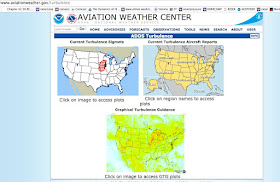My favorite is from the NOAA/NWS Aviation Weather Center on their ADDS Turbulence website (www.aviationweather.gov/turbulence). You can see an example below. This page has turbulence SIGMETa (colored turbulence warming areas) in the upper left, pilot reports of turbulence (PIREPS) in the upper right, and model-driven turbulence forecasts at many levels and times (bottom panel).
The pilot reports are particularly useful and they are color-coded (green for light, orange for moderate, and red for severe). Below is a recent example for the Midwest.
Turbulence symbols look like strange omega symbols--here is a blow up of how they look:Light turbulence is routine--a modest movement that is not even uncomfortable, sort of like driving on a rough rode. Moderate turbulence makes it a bit uncomfortable to walk around, but generally doesn't send things airborne (although the seat belt sign is virtually always on in moderate turbulence). Finally, there is severe, which CAN send you airborne.
The final plot (on the bottom) provides forecasts of non-convective turbulence (from wind shear and mountain waves). It is useful, but sometimes gets the pattern wrong.
To check out turbulence on an international route, go to this NOAA site: /www.aviationweather.gov/progchart. An example over the Pacific (shown below) indicates turbulence with yellow dashed lines and thunderstorms by the scalloped red areas. The Great Circle route to Japan looks clear, except for some thunderstorms over Japan.
Another source, and one particularly good for international routes, is turbulenceforecast.com. They have some of the same things as the NOAA site, but they have other products as well. You can even sign up for warnings.
You want some advice on lessening your exposure to turbulence? Fly early in the day, because thunderstorms are generally less frequent then. Don't sit in the back of the plane, which tends to be bumpier. Avoid switching planes in Denver (a notoriously bumpy place to land any time of the year). And fly as big an aircraft as possible. But most important of all is to lock your seatbelt at all times. Not all turbulence is forewarned. And having your head go through the ceiling is unpleasant.
Announcements:
At the UW, we have developed a wonderful FREE weather app for Android smartphones that also collects pressure for use in weather forecasting. If you want to try it, please go to the Google PlayStore and download it.
I will be talking in Port Angeles about the Future of the Pacific Northwest Under Global Warming at 6:30 PM on August 17th. More information here.





I know you mentioned this, but it bears more emphasis. Stay in your seats with your seatbelts fastened, people! I am amazed when I fly to see many people spending most of the flight up and walking around, as if they were not moving at 600mph through an often unpredictable medium.
ReplyDeleteAsk any pilot--this is what they do, because they know that turbulence can be unexpected.